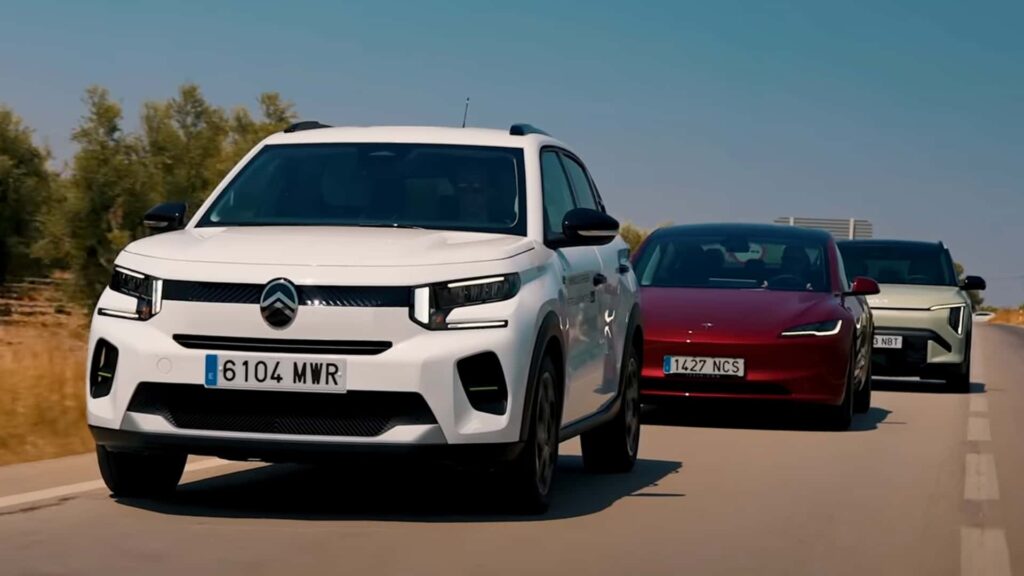The impact of extreme temperatures on electric vehicle (EV) range has been a topic of interest for many researchers and enthusiasts alike. A recent test conducted by a UK-based publication in southern Spain shed light on how three different EVs fared in scorching heat, with temperatures reaching as high as 111°F (44°C) and the cars being driven at highway speeds.
The three EVs tested were the Citroen e-C3, Kia EV3, and Tesla Model 3 Long Range dual-motor. Each car had a different battery size and claimed range, with the Tesla boasting the highest claimed range of 436 miles (702 km). However, all three vehicles experienced a significant gap between their claimed range and real-world performance in the extreme heat.
The Citroen e-C3, with its small air-cooled 44 kWh battery, struggled the most in the heat. It was estimated to have a range of only 142 miles, which was 28.7% less than its advertised range. The Kia EV3 and Tesla Model 3 fared slightly better, with estimated ranges of 246 miles and 244 miles respectively, representing a 32% and 44% difference from their claimed ranges.
Despite the decrease in range, both the Kia and Tesla were able to charge relatively quickly in the extreme heat. The Tesla, in particular, was able to charge from 9% to 80% in just 32 minutes, close to its official 27-minute claim. The Kia also performed well, taking only 31 minutes to reach the same charging level.
Interestingly, the test also revealed that the Kia and Tesla were less affected by the high temperatures compared to the Citroen. Both vehicles were able to charge efficiently and come close to their official fast charging times, showcasing the effectiveness of their battery thermal management systems.
Overall, the test highlighted the importance of considering extreme temperatures when evaluating EV performance and range. It also emphasized the need for advanced battery thermal management systems to mitigate the impact of heat on EV range. As EV technology continues to evolve, it will be interesting to see how manufacturers address the challenges posed by extreme weather conditions to ensure optimal performance and efficiency. Recently, a group of journalists conducted a test comparing the range of electric vehicles, including a Tesla Model 3 with a full-length glass roof. The journalists found that the Tesla’s glass roof, along with the cover, had a significant impact on the cabin temperature. In fact, they had to run the air conditioning on a higher setting to keep the cabin cool, ultimately affecting the final range result of the vehicle.
The journalists noted that the need to increase the air conditioning had a more significant impact on the Tesla’s range compared to the other two cars in the test. This highlights the importance of considering all factors that can affect the range of an electric vehicle, including features such as a full-length glass roof.
The Tesla Model 3’s full-length glass roof is a unique feature that provides a panoramic view for passengers. However, it also presents challenges in terms of heat management and energy consumption. The journalists’ test results indicate that the glass roof may lead to a higher demand for air conditioning, which in turn can impact the overall range of the vehicle.
As electric vehicles continue to gain popularity, manufacturers will need to address the trade-offs between design features and energy efficiency. The Tesla Model 3’s full-length glass roof is just one example of how a unique feature can have unintended consequences on range and energy consumption.
In conclusion, the journalists’ test of the Tesla Model 3 with a full-length glass roof highlights the importance of considering all factors that can impact the range of an electric vehicle. Features such as a glass roof may enhance the driving experience, but they can also affect energy consumption and range. As technology continues to evolve, it will be interesting to see how manufacturers address these challenges to optimize the performance of electric vehicles.

